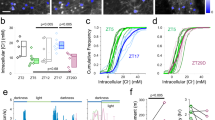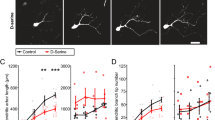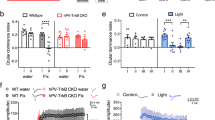Abstract
Numerous protein kinases have been implicated in visual cortex plasticity, but the role of serine/threonine protein phosphatases has not yet been established. Calcineurin, the only known Ca2+/calmodulin-activated protein phosphatase in the brain, has been identified as a molecular constraint on synaptic plasticity in the hippocampus and on memory. Using transgenic mice overexpressing calcineurin inducibly in forebrain neurons, we now provide evidence that calcineurin is also involved in ocular dominance plasticity. A transient increase in calcineurin activity is found to prevent the shift of responsiveness in the visual cortex following monocular deprivation, and this effect is reversible. These results imply that the balance between protein kinases and phosphatases is critical for visual cortex plasticity.
This is a preview of subscription content, access via your institution
Access options
Subscribe to this journal
Receive 12 print issues and online access
$209.00 per year
only $17.42 per issue
Buy this article
- Purchase on Springer Link
- Instant access to full article PDF
Prices may be subject to local taxes which are calculated during checkout







Similar content being viewed by others
References
Roberts, E.B., Meredith, M.A. & Ramoa, A.S. Suppression of NMDA receptor function using antisense DNA block ocular dominance plasticity while preserving visual responses. J. Neurophysiol. 80, 1021–1032 (1998).
Daw, N.W. et al. Injection of MK-801 affects ocular dominance shifts more than visual activity. J. Neurophysiol. 81, 204–215 (1999).
Beaver, C.J., Ji, Q., Fischer, Q.S. & Daw, N.W. Cyclic AMP-dependent protein kinase mediates ocular dominance shifts in cat visual cortex. Nat. Neurosci. 4, 159–163 (2001).
Taha, S., Hanover, J.L., Silva, A.J. & Stryker, M.P. Autophosphorylation of alphaCaMKII is required for ocular dominance plasticity. Neuron 36, 483–491 (2002).
Di Cristo, G. et al. Requirement of ERK activation for visual cortical plasticity. Science 292, 2337–2340 (2001).
Mansuy, I.M. Calcineurin in memory and bidirectional plasticity. Biochem. Biophys. Res. Commun. 311, 1195–1208 (2003).
Winder, D.G. & Sweatt, J.D. Roles of serine/threonine phosphatases in hippocampal synaptic plasticity. Nat. Rev. Neurosci. 2, 461–474 (2001).
Klee, C.B., Crouch, T.H. & Krinks, M.H. Calcineurin: a calcium- and calmodulin-binding protein of the nervous system. Proc. Natl. Acad. Sci. USA 76, 6270–6273 (1979).
Goto, S. et al. Cellular colocalization of calcium/calmodulin-dependent protein kinase II and calcineurin in the rat cerebral cortex and hippocampus. Neurosci. Lett. 149, 189–192 (1993).
Goto, S., Singer, W. & Gu, Q. Immunocytochemical localization of calcineurin in the adult and developing primary visual cortex of cats. Exp. Brain Res. 96, 377–386 (1993).
Lieberman, D.N. & Mody, I. Regulation of NMDA channel function by endogenous Ca(2+)-dependent phosphatase. Nature 369, 235–239 (1994).
Tong, G., Shepherd, D. & Jahr, C.E. Synaptic desensitization of NMDA receptors by calcineurin. Science 267, 1510–1512 (1995).
Ehlers, M.D. Reinsertion or degradation of AMPA receptors determined by activity-dependent endocytic sorting. Neuron 28, 511–525 (2000).
Lee, H.K., Barbarosie, M., Kameyama, K., Bear, M.F. & Huganir, R.L. Regulation of distinct AMPA receptor phosphorylation sites during bidirectional synaptic plasticity. Nature 405, 955–959 (2000).
Genoux, D. et al. Protein phosphatase 1 is a molecular constraint on learning and memory. Nature 418, 970–975 (2002).
Morishita, W. et al. Regulation of synaptic strength by protein phosphatase 1. Neuron 32, 1133–1148 (2001).
Torii, N., Kamishita, T., Otsu, Y. & Tsumoto, T. An inhibitor for calcineurin, FK506, blocks induction of long-term depression in rat visual cortex. Neurosci. Lett. 185, 1–4 (1995).
Funauchi, M., Haruta, H. & Tsumoto, T. Effects of an inhibitor for calcium/calmodulin-dependent protein phosphatase, calcineurin, on induction of long-term potentiation in rat visual cortex. Neurosci. Res. 19, 269–278 (1994).
Mansuy, I.M., Mayford, M., Jacob, B., Kandel, E.R. & Bach, M.E. Restricted and regulated overexpression reveals calcineurin as a key component in the transition from short-term to long-term memory. Cell 92, 39–49 (1998).
Antoni, F.A. et al. Ca2+/calcineurin-inhibited adenylyl cyclase, highly abundant in forebrain regions, is important for learning and memory. J. Neurosci. 18, 9650–9661 (1998).
Coghlan, V.M. et al. Association of protein kinase A and protein phosphatase 2B with a common anchoring protein. Science 267, 108–111 (1995).
Oliveria, S.F., Gomez, L.L. & Dell'Acqua, M.L. Imaging kinase–AKAP79–phosphatase scaffold complexes at the plasma membrane in living cells using FRET microscopy. J. Cell Biol. 160, 101–112 (2003).
Rao, Y. et al. Reduced ocular dominance plasticity and long-term potentiation in developing visual cortex of protein kinase A RIIα mutant mice. Eur. J. Neurosci. 20, 837–842 (2004).
Fischer, Q.S. et al. Requirement for the RIIbeta isoform of PKA, but not calcium-stimulated adenylyl cyclase, in visual cortical plasticity. J. Neurosci. 24, 9049–9058 (2004).
Goto, S. et al. Cellular localization of type II Ca2+/calmodulin-dependent protein kinase in the rat basal ganglia and intrastriatal grafts derived from fetal striatal primordia, in comparison with that of Ca2+/calmodulin-regulated protein phosphatase, calcineurin. Neuroscience 62, 695–705 (1994).
Bito, H., Deisseroth, K. & Tsien, R.W. CREB phosphorylation and dephosphorylation: a Ca(2+)- and stimulus duration-dependent switch for hippocampal gene expression. Cell 87, 1203–1214 (1996).
Pham, T.A., Impey, S., Storm, D.R. & Stryker, M.P. CRE-mediated gene transcription in neocortical neuronal plasticity during the developmental critical period. Neuron 22, 63–72 (1999).
Mower, A.F., Liao, D.S., Nestler, E.J., Neve, R.L. & Ramoa, A.S. cAMP/Ca2+ response element-binding protein function is essential for ocular dominance plasticity. J. Neurosci. 22, 2237–2245 (2002).
Gordon, J.A. & Stryker, M.P. Experience-dependent plasticity of binocular responses in the primary visual cortex of the mouse. J. Neurosci. 16, 3274–3286 (1996).
Polli, J.W., Billingsley, M.L. & Kincaid, R.L. Expression of the calmodulin-dependent protein phosphatase, calcineurin, in rat brain: developmental patterns and the role of nigrostriatal innervation. Brain Res. Dev. Brain Res. 63, 105–119 (1991).
Robertson, A., Perea, J., Tolmachova, T., Thomas, P.K. & Huxley, C. Effects of mouse strain, position of integration and tetracycline analogue on the tetracycline conditional system in transgenic mice. Gene 282, 65–74 (2002).
Paul, S., Nairn, A.C., Wang, P. & Lombroso, P.J. NMDA-mediated activation of the tyrosine phosphatase STEP regulates the duration of ERK signaling. Nat. Neurosci. 6, 34–42 (2003).
Giese, K.P., Fedorov, N.B., Filipkowski, R.K. & Silva, A.J. Autophosphorylation at Thr286 of the alpha calcium-calmodulin kinase II in LTP and learning. Science 279, 870–873 (1998).
Cancedda, L. et al. Patterned vision causes CRE-mediated gene expression in the visual cortex through PKA and ERK. J. Neurosci. 23, 7012–7020 (2003).
Taha, S. & Stryker, M.P. Rapid ocular dominance plasticity requires cortical but not geniculate protein synthesis. Neuron 34, 425–436 (2002).
Groth, R.D., Dunbar, R.L. & Mermelstein, P.G. Calcineurin regulation of neuronal plasticity. Biochem. Biophys. Res. Commun. 311, 1159–1171 (2003).
Cameron, A.M. et al. Calcineurin associated with the inositol 1,4,5-trisphosphate receptor-FKBP12 complex modulates Ca2+ flux. Cell 83, 463–472 (1995).
Iwai, Y., Fagiolini, M., Obata, K. & Hensch, T.K. Rapid critical period induction by tonic inhibition in visual cortex. J. Neurosci. 23, 6695–6702 (2003).
Fagiolini, M. et al. Specific GABAA circuits for visual cortical plasticity. Science 303, 1681–1683 (2004).
Berardi, N., Pizzorusso, T. & Maffei, L. Extracellular matrix and visual cortical plasticity: freeing the synapse. Neuron 44, 905–908 (2004).
Oray, S., Majewska, A. & Sur, M. Dendritic spine dynamics are regulated by monocular deprivation and extracellular matrix degradation. Neuron 44, 1021–1030 (2004).
Zhou, Q., Homma, K.J. & Poo, M.M. Shrinkage of dendritic spines associated with long-term depression of hippocampal synapses. Neuron 44, 749–757 (2004).
Lautermilch, N.J. & Spitzer, N.C. Regulation of calcineurin by growth cone calcium waves controls neurite extension. J. Neurosci. 20, 315–325 (2000).
Fansa, H. et al. Stimulation of Schwann cell proliferation and axonal regeneration by FK 506. Restor. Neurol. Neurosci. 16, 77–86 (2000).
Heynen, A.J. et al. Molecular mechanism for loss of visual cortical responsiveness following brief monocular deprivation. Nat. Neurosci. 6, 854–862 (2003).
Hensch, T.K. et al. Comparison of plasticity in vivo and in vitro in the developing visual cortex of normal and protein kinase A RIbeta-deficient mice. J. Neurosci. 18, 2108–2117 (1998).
Renger, J.J. et al. Experience-dependent plasticity without long-term depression by type 2 metabotropic glutamate receptors in developing visual cortex. Proc. Natl. Acad. Sci. USA 99, 1041–1046 (2002).
Daw, N., Rao, Y., Wang, X.F., Fischer, Q. & Yang, Y. LTP and LTD vary with layer in rodent visual cortex. Vision Res. 44, 3377–3380 (2004).
Sawtell, N.B. et al. NMDA receptor-dependent ocular dominance plasticity in adult visual cortex. Neuron 38, 977–985 (2003).
Pham, T.A. et al. A semi-persistent adult ocular dominance plasticity in visual cortex is stabilized by activated CREB. Learn. Mem. 11, 738–747 (2004).
Acknowledgements
This work was supported by Public Health Service Grant R01 EY00053 and the Connecticut Lions Eye Research Foundation. I.M.M. is supported by the University of Zürich, the Swiss Federal Institute of Technology, the Swiss National Science Foundation, Swiss National Centre for Competence in Research 'Neural Plasticity and Repair', European Molecular Biology Organization, Human Frontier Science Program. N.W.D. is a Senior Science Investigator of Research to Prevent Blindness. We thank D. Winder for providing the mice, A. LaRue for help with PCR, R. Munton for help with synaptosomal preparations, and Y. Rao for help with the LTD measurements.
Author information
Authors and Affiliations
Corresponding author
Ethics declarations
Competing interests
The authors declare no competing financial interests.
Supplementary information
Supplementary Fig. 1
Lack of ocular dominance plasticity with an intact onset of the critical period in CNO mice. (a) Calcineurin transgene is suppressed by doxycycline treatment from birth to P21 after the typical onset of the critical period (P19, Gordon and Stryker, 1996). The animals are monocularly deprived at P28, and recordings are performed four days later. (b) Columns showing ocular dominance distribution after monocular deprivation in CNO mice, which is identical to that in non–deprived wild–type mice (solid line), but significantly different from that in deprived wild–type mice (dash line, P < 0.0001, χ 2 test), indicating the impaired ocular dominance plasticity. (GIF 5 kb)
Supplementary Fig. 2
LTD is normal in visual cortex in CNO mice. LTD was induced by 15-min 1-Hz presynaptic stimulation paired with postsynaptic depolarization in CNO mice (77 ± 5%, n = 8; P < 0.01, compare to the baseline), which was identical to that observed in wild type animals (74.7 ± 3.1%). (GIF 17 kb)
Rights and permissions
About this article
Cite this article
Yang, Y., Fischer, Q., Zhang, Y. et al. Reversible blockade of experience-dependent plasticity by calcineurin in mouse visual cortex. Nat Neurosci 8, 791–796 (2005). https://doi.org/10.1038/nn1464
Received:
Accepted:
Published:
Issue Date:
DOI: https://doi.org/10.1038/nn1464



